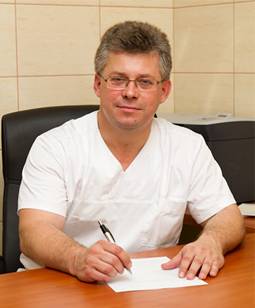„Outcome of combined treatment of chondromalacia of the knee using arthroscopic debridement and rehabilitation, on the basis of original material”
Wziętek B.1, Frańczuk B.2, Mańko G.3
1 Trauma and Orthopeadic Ward, County Hospital in Chrzanów
2 Clinic of Orthopeadics and Rehabilitation Collegium Medicum UJ in Kraków,
3 Rehabilitation Ward, County Hospital in Chrzanów
Aims
Chondromalacia without treatment leads to osteoarthritis. Adequate and early treatment can stop this process. The work presents the theoretical basis and outcome of the treatment of chondromalacia in the knee, using a combined method of arthroscopy and rehabilitation
Methods
The arthroscopic work on the knee involved levelling the damaged cartilage surface using manual tools, shaver and vaporizer, drilling or microfractures of the subchondral layer of the bone, shaving of hypertrophied synovium, and lateral release of the patella if needed. An authorial rehabilitation program was applied. In the beginning it consisted of: isometric exercises of quadriceps muscle, continuous passive motion, and cold compress on the knee. Later active exercises, walking without weightbearing, and autostretching in flexion contracture were applied. The ambulatory rehabilitation relied on further kinesitherapy and physiotherapy.
Results
The outcome was evaluated average 19 months (from 4 to 30 months) after surgery using the questionnaire based on Lysholm-Gilquist Scale. The mean improvement was 34 points in Lysholm-Gilquist Scale (average from 49 before to 83,0 after). The results in different groups according to: age, grade of chondromalacia, location of chondromalacia and according to the method of treatment are given below.
The improvement in groups after lateral release of patella was lower than average 26. The group treated with microfractures (31) had better results than the group treated with drilling (22). Patients treated with shaving (32) had worse results than those treated additionally with vaporisation (38).
Conclusion
The combined treatment of chondromalacia of the knee using arthroscopic debridement and rehabilitation gives good results in most cases of chondromalacia up to grade III.
Tab. 1. Population by age groups
| Number of the group | Age range | Number of patients | percentage |
|---|---|---|---|
| I | up to 19 years | 2 | 4,3 |
| II | 20 do 29 | 5 | 10,9 |
| III | 30 do 39 | 10 | 21,7 |
| IV | 40 do 49 | 19 | 41,3 |
| V | 50 do 59 | 4 | 8,7 |
| VI | above 60 years | 4 | 8,7 |
Tab. 2. Group of patients with chondromalacia according to degree
| Grade of chondromalacia | number | % |
|---|---|---|
| I | 1 | 2 |
| II | 17 | 39 |
| III | 15 | 34 |
| IV | 11 | 25 |
Tab. 3. Rehabilitation program used in Chrzanów County Hospital for patients following arthroscopic repair of damage to knee cartilage
| Rehabilitation treatment | Time from the surgery | Methods | Aims of rehabilitation |
|---|---|---|---|
| Continuous passive movement | 2nd-5th day, later 15x ambulatory | 3 x 1 hour | edema-reducing, maintaining of full range of motion cartilage nutrition |
| Isometrical exercises of quadriceps femoris | from 1st day | 200 x a day in series 8 – 15 every hour | maintaining stereotypes of movement and propiocepcion |
| Active exercises of lower limb | from 2nd day | 200 x a day in series 8 – 15 every hour | Maintaining of muscle strength and ROM, cartilage nutrition |
| Walking without weightbearing | from 2nd day | Assistance of a physiotherapist | Teaching of one leg ambulation |
| Full weightbearing | depends on region of damage of cartilage | Under guidance of a physiotherapist | Cartilage nutrition Teaching of corect ambulation |
| Active exercises with resistance | after 6 weeks | Cycloergometer | Increase of muscle mass |
| Exercises on a cycloergometer | from second week | Home exercises without resistance | Edema-reducing, maintaining of full range of motion cartilage nutrition |
| Magnetronic | from 3rd week | 15 x 20 minute | Edema-reducing cartilage regeneration |
| Muscle electrostimulation | from 3rd week | In case of muscle atrophy | Muscle rebuilding |
| Jonoforesis (diclofenac) | from 3rd week | 10 x in programme | Anti-inflammatory |
| Infrared | from 6th week | 10 x 15 minute before exercises | Muscle tendons, and joint capsule relaxation |
Tab. 4. Average results of surgical treatment and rehabilitation per group
| Group | n | before | after | improvement |
|---|---|---|---|---|
| Localization in joint | ||||
| Patello-femoral | 15 | 56 | 89 | 33 |
| Tibio-femoral | 18 | 47 | 82 | 35 |
| spread | 11 | 46 | 85 | 39 |
| Grade of chondromalacia | ||||
| I and II | 17 | 57 | 90 | 33 |
| III and IV | 27 | 44 | 78 | 34 |
| Results after different needed procedures | ||||
| Lateral release of patella | 14 | 56 | 82 | 26 |
| Drilling of chondral defects | 6 | 50 | 72 | 22 |
| Microfractures of chondral defects | 4 | 37 | 68 | 31 |
| Shaving | 16 | 47 | 79 | 32 |
| Vaporization+shaving | 7 | 38 | 76 | 38 |


